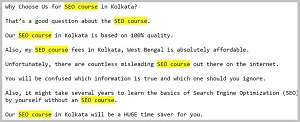On-Page Optimization Tricks Google Hates On Websites
 We all want our pages, if not sites to rank high in Google searches, however, several techniques can be counter-productive when it comes to page optimization. The Google search algorithm is quick to catch on to site creators when they try to play the system. However, people still try the same tricks. The worry is, this can end up hurting more than serving your search ranking.
We all want our pages, if not sites to rank high in Google searches, however, several techniques can be counter-productive when it comes to page optimization. The Google search algorithm is quick to catch on to site creators when they try to play the system. However, people still try the same tricks. The worry is, this can end up hurting more than serving your search ranking.
Here are several techniques that Google isn’t fond of. It’s best to do everything you can to steer clear of these if you can.
Keyword Stuffing
This means that you are using the target keywords for the page over and over again. The issue is that this reads very poorly and Google is all about user experience over everything else.
To avoid this, make sure that your keywords are lined up with your page title and description. Also, the right keyword usage count is about once per 100 words or even less. Remember, in this case, less is more.

Not Optimizing for Mobile
As of March 2021, Google will index your website based on its mobile presentation first. Meaning that you have to make sure that you spend the same amount of time on mobile optimization as on desktop optimization. Almost all site creation tools provide you with the ability to both view and optimize for mobile, so now is the time to use it.

Using Misleading Keywords
What the above means is that you have a keyword in your title that doesn’t match with the content. A good instance of this is when your title contains the words “Rebecca Masina” yet the page has nothing to do with Rebecca whatsoever. What you’re doing is deceiving the search engine to send you traffic that you don’t deserve since you don’t have anything to offer on the topic. Google hates this and will make you pay for that violation.
Bloated Footers
Same as keyword stuffing, stuffed footers mean that your footer is filled with lots of tags and links that don’t have meaning to the page or website. Take a look at big corporate websites and you’ll see they have dozens of links, though they’re all logical to the website. Spammy footers are a great way to get on Google’s wicked side, yet that can be avoided.
There are other possible issues that you can read about, but the simplest thing to remember is that user experience comes first. If something is misleading to the user will result in a Google penalty. So, that should call for a fresh look at your page optimization.


